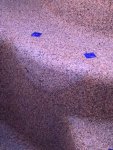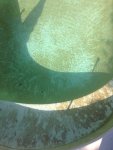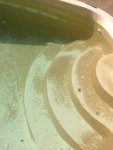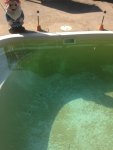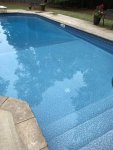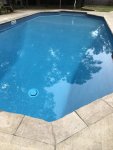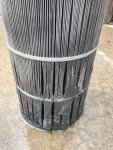I do not blame you one bit for feeling discouraged. Maybe at this point it might be more helpful to take an expense reduction approach. I fear that if there's truly no high concentration of metals in your source water or the overall pool water, that the sequestrant levels are largely only to benefit a small area, rendering the expense and pita factor too exorbitant.
Lets see if we can work on the goal of at least reducing your sequestrant cost and ruling out other possibilities before entertaining destructive options, if you have the energy and motivation for it

With that said, the next time you change the liner, ask for a barrier foam or sheet to be on the safe side, and consider a tan liner, which I suspect may hide it more if this is a case of iron blown in from surrounding soil and settling on the floor, or alternately, of surround infiltration. Leak testing with dye on areas near the staining might also be informative.
For example, I was sure i had no leaks, but when they actually changed the liner, I did have a pinhole leak behind my side ladder that allowed water to infiltrate into the corner where my worst staining was. So whether I knew it or not, my worst stain area was exacerbated by small amounts of untreated water behind the liner. (My new liner is a pattern called Reef that was selected specifically not to show iron as readily, btw...its a mix of Black and Tan and beige and blue.)
But instead of taking it all on at once, keep all explanation options open and give yourself space between to just enjoy the pool. Trust me on this...I spent a few years on my issue...and still spend thought and time on strategies going forward.
The way to have it not drive you crazy is to realize this may be a multimodal problem with multiple variables that can be slowly remedied over time but that may not wholly add up to a definitive dx right now.
I have one idea that might be worth trying on two fronts - with caution or an alternate substance. Its what ive rcommended in the past for copper treatment, for which ive heard reports of success. I'd like to find out if acid or Metal Magic lightens the stains. I wish you were a neighbor because there is a tool called purity spot remover i own that lets you fill the small cartridge with Muriatic acid and rub it o a spot. If MA removes the staining, over a season it would be a lot cheaper to invest in an Underwater Acid Wand made by the same company and use small amounts of MA every 7-10 days when the staining returns - carefully, of course, as too much acid may harm the liner. Alternately, it might be best/safer to instead try with metal magic first...but the reduction in cost comes from direct area application instead of "whole water" sequestering...thereby saving the constant cycle of AA, followed by $100 worth of Jacks for a mere week of stain free living.
So, these tools are meant for acid, and meant for plaster pools but I have used both acid (lightly) on my old liner AND a mixture of small amounts of AA or Citric Acid with water on the small spot tool.
Here are links for review..the small tool:
https://www.amazon.com/Purity-Pool-OS-Stain-Remover/dp/B004VLB3VE/ref=sr_1_1?ie=UTF8&qid=1494585224&sr=8-1&keywords=purity+pool
The big wand:
https://www.amazon.com/Purity-Pool-UAW-Underwater-Acid/dp/B00C7UGLFY/ref=sr_1_1?ie=UTF8&qid=1494585311&sr=8-1&keywords=purity+pool+underwater+acid
If you read the metal magic sponge test, you will be now realize that sequestrant, at least ths brand, CAN remove fresh staining on direct contact. So perhaps doing the sponge test is a cheap way to find out if "direct application" is worth pursuing. If it lifts immediately with the sponge test, you'd then know that a wand application might nail it quickly enough. Side benefit is that you're still adding sequestrant to prevent accumulation.
If through this experiment you were to learn that eg. I bottle of MM at $17 3x a month, or a cup of AA, or less, or part of a jug (with caution!) removed the staining, would that improve the quality of you life and your relationship with the pool? If it would, it may be worth a try.
While experimenting with the "direct contact/preserve funds" approach, over time as the sequestrant level slowly drops, you might be able to find the place where a "lighter" treatment touch gets you by, and at the same time, test both sequestrant and iron levels weekly. If you approach it as a longer term experiment as opposed to a solution, I think it will help your frustration level.
I don't know if I'm articulating this well, but I'm just hopeful that you can take some solace in shifting approach.
This comes from a place where experience has, at times quite humorously, shown me that a binary solution approach will ultimately disappoint me.
For example, switched my water source to softened water one year..,and did decrease my iron ppm over the course of several seasons...so why was there still iron that had to be managed? Turns out, testing showed that my softener was exhausting itself on top ups and some raw water was getting in. So I upgraded to a dual softener. That helped. I was still getting trace copper. Well, my heat exchanger had corroded

I also discovered that even softened water - through testing -- still in my case carried .5 ppm iron. So last year I started using a 10" reducing filter on spigot, which gets it down by another half.
Then due to liner change, I had brand new water trucked in for $1k. To my surprise and chagrin, within a month I was reading iron again. Discovered that mst salt used in SWG carries trace amounts of iron that can come out of solution during electrolysis. Discovered a corroding ladder. Also discovered that the stain that drove me the craziest was most likely coming from behind the liner during the liner change

But here I am, after running through winter, still spot cleaning my steps now with AA, and still (in a very reduced fashion) using sequestrant....which I will also need to treat once a season to prevent high volumes of built up spent sequestrant

-- you get the idea here

In short, over 6 years of pool ownership on a well, I've come to learn that while ive made vast improvements in my metal management strategy, ultimately and ongoingly, it is still a work in progress...in my case, due to variables beyond my direct control such as well water.
In your case, I suspect your soil AND occasionally your source water, and yes, your salt, and the design of the structure with in-floor jets are contributing factors that may be difficult to suss out and ultimately control. For example, some municipalities use sequestrant, especially on runs that go through old iron pipes. The water coming out of the spigot can read no iron, but the oxidization and natural wear down of the sequestrant can a month later show iron as it comes out of solution

So, the "why's" can drive you crazy. Try diect application/mitigation and see if it helps reduce your frustration, then slowly test over time to see what conclusions you can draw from combined consideration of factors. And pease kerp us updated. Whether you know it or not, ths thread and a chart of your progress will ultimately help others to come











